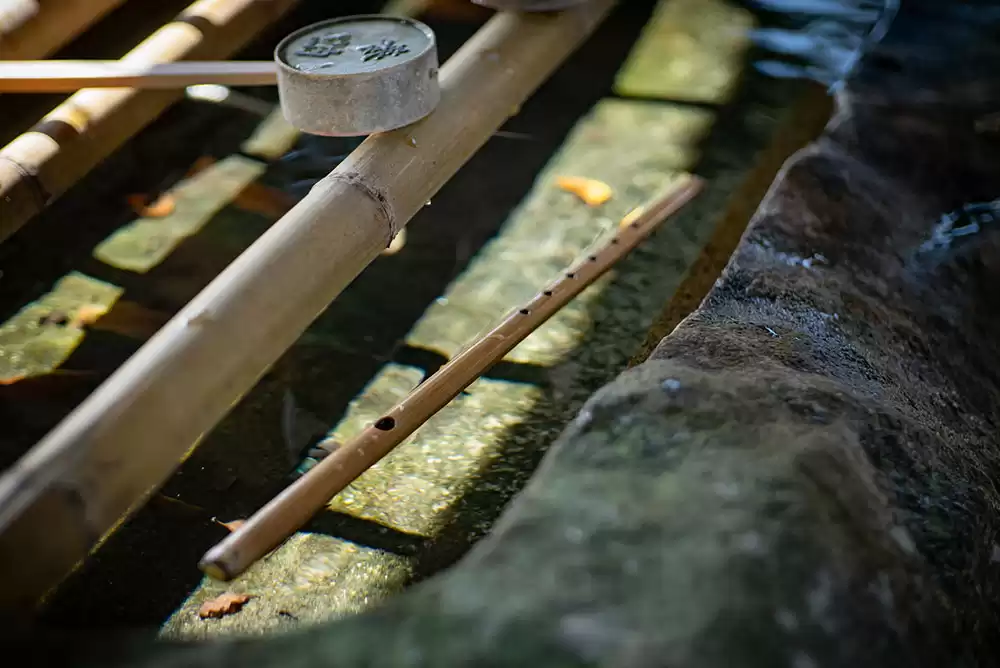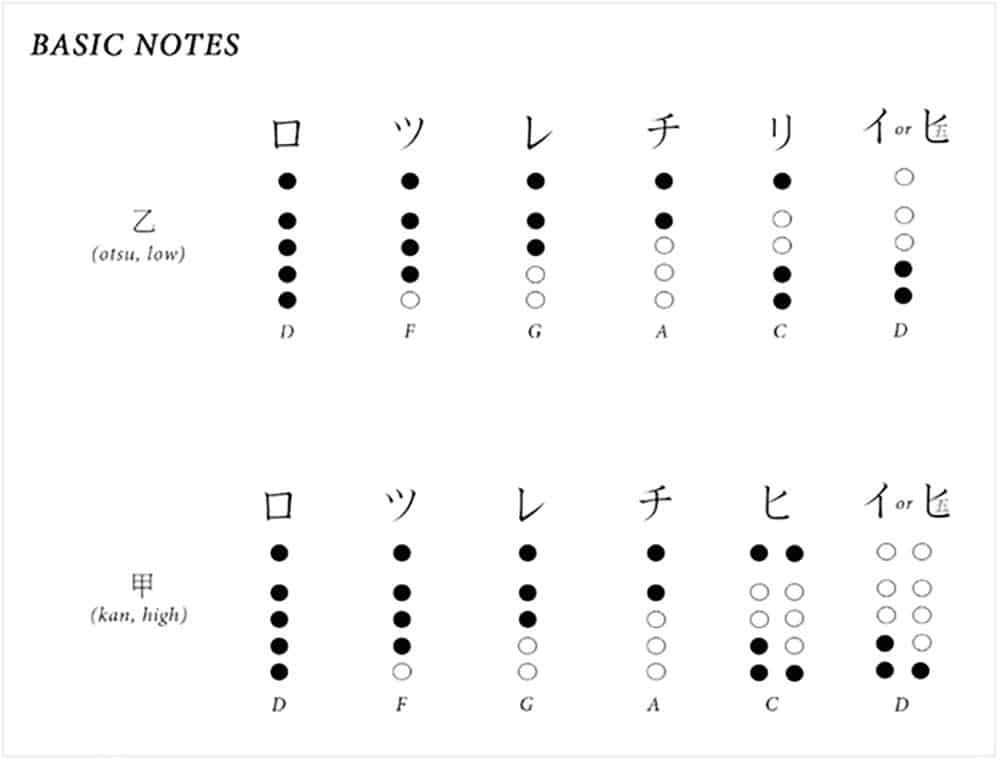
01 Dec Shakuhachi Fingering Chart
Playing the shakuhachi flute is an art, and mastering the intricacies of this Japanese instrument can be a profound and rewarding journey. Here is our comprehensive shakuhachi fingering chart and information on where to take shakuhachi lessons.
Basic Shakuhachi Fingerings

Let’s begin with the fundamentals. The shakuhachi flute has five finger holes, which are tuned to a pitch between 440 and 442 Hz. These basic fingerings are your starting point:
Dai Kan – All holes covered (O O O O O)
Ro Kan – All holes closed except the bottom one (X X X X O)
Re Kan – All holes closed except the top one (O X X X X)
Chu Kan – The top three holes are closed, and the bottom two are open (X X X O O)
Kan – All holes open (X X X X X)
These foundational fingerings will give you a baseline for learning how to play shakuhachi.
Advanced Fingerings and Techniques
As you progress, you’ll unlock advanced fingerings and techniques that allow you to express your musical creativity with the shakuhachi. Let’s delve deeper into these advanced aspects:
1. Half-Holing
Half-holing is a technique that involves partially covering a finger hole to produce microtonal variations in pitch. It’s a subtle but powerful tool that can add nuance and expression to your music. You can create intricate melodies and embellishments by mastering the control over which holes you partially close.
2. Meri (Flattening) and Kari (Sharpening) Notes
Meri and kari techniques involve changing the angle at which you blow into the shakuhachi to flatten or sharpen specific notes. These techniques allow you to navigate the full range of the instrument and achieve the desired tonal quality for each note.
3. Multiphonics
Multiphonics is when you produce more than one note simultaneously. By manipulating your embouchure and fingerings, you can create harmonies or dissonances that add depth and complexity to your compositions as a beginner shakuhachi player.
4. Sliding Techniques
Sliding techniques such as glissando occur when you transition smoothly between notes, creating an ethereal effect. These techniques require finesse and control and are a hallmark of advanced shakuhachi playing.
5. Circular Breathing
Circular breathing allows you to maintain a continuous flow of sound without interruption. It’s especially handy when playing extended phrases and maintaining the shakuhachi’s ethereal quality.
6. Expressive Vibrato
Mastering vibrato adds warmth and emotion, which is a crucial aspect to how the shakuhachi is played. By modulating your breath control and embouchure, you can create a rich, pulsating quality that adds depth to your melodies.
7. Tonal Manipulation
Advanced players explore tonal manipulation techniques that can alter the shakuhachi’s timbre. These techniques include flutter-tonguing, which creates a fluttering sound, and pitch bending, where the pitch is smoothly bent between notes.
By incorporating advanced fingerings and techniques into your shakuhachi repertoire, you’ll be able to showcase the depth and versatility of this mesmerizing instrument.
Notation System for Shakuhachi
Understanding the notation system for shakuhachi music is a crucial step for any beginner shakuhachi player. The notation system bridges the gap between the written score and the mesmerizing sounds that emanate from a shakuhachi flute. Here’s a comprehensive look at the musical notation system:
1. Traditional Japanese Notation
Traditional Japanese notation systems like Kinko-ryu notation and Myoan-ryu notation are commonly used for the shakuhachi flute.
Kinko-ryu Notation: This system is characterized by a combination of kanji characters, hiragana, and specific symbols to represent fingering, note duration, and ornamentation.
Myoan-ryu Notation: Myoan-ryu notation employs kanji characters and specific symbols to convey fingering and nuances in performance.
2. Western Musical Notation
Western musical notation is often incorporated alongside traditional Japanese notation in shakuhachi music, allowing for a standardized way of representing pitch, rhythm, and other musical elements.
3. The Shakuhachi Fingering Chart as a Learning Aid
Incorporating the shakuhachi fingering chart into your practice and study sessions is immensely helpful as a beginner shakuhachi player. It provides a visual reference to accompany written scores, enabling you to associate fingerings with specific notes and techniques during shakuhachi lessons.
Traditional Japanese Music Scales: A Harmonious Journey
The shakuhachi is known for its unique scales and tonalities. Understanding these scales enriches your playing and deepens your connection to the instrument’s Japanese heritage. Here’s a closer look at these traditional Japanese music scales:
1. The Pentatonic Scale (Ritsu, Hyo, Iwato, Yo, Daito)
The pentatonic scale is at the heart of traditional Japanese music and is the foundation of Shakuhachi compositions. It consists of five notes: Ritsu, Hyo, Iwato, Yo, and Daito. Each note has a distinct character and emotion, allowing for a wide range of expression in your music.
2. The Hirajoshi Scale
The Hirajoshi scale is a five-note scale characterized by its intervals, which create a distinct and evocative Japanese sound. Learning to navigate this scale adds depth and authenticity to your shakuhachi playing.
3. The Akebono Scale
The Akebono scale consists of seven notes and is known for its melancholic and contemplative quality. It is often used in traditional Japanese court music.
4. The Kumoi Scale
The Kumoi scale is a seven note scale known for its serene and tranquil character. It is frequently used in traditional Japanese koto music.
Delving into these traditional Japanese music scales can help you create more captivating, authentic performances that resonate with the soul.
Tips for Improving Fingering Precision: Navigating the Path to Mastery
Fingering precision is the cornerstone of beautiful shakuhachi music. Try using the following tips to enhance your fingering accuracy and control:
1. Practice Regularly
Consistent practice is the most essential factor in improving fingering precision. Scheduling time every day to play your shakuhachi builds muscle memory and dexterity.
2. Mirror Technique
Play the shakuhachi in front of a mirror to observe your finger positions and make real-time adjustments. The more shakuhachi lessons you take, the more you’ll develop a keen sense of finger placement.
3. Controlled Breath
Maintain consistent and controlled airflow while taking shakuhachi lessons. Practicing controlled breathing techniques will only help improve your overall performance.
4. Slow Practice
Start by playing slowly and deliberately, focusing on each fingering transition to ensure accuracy and smoothness. Gradually increase the tempo of the songs you play as your proficiency develops.
5. Record Yourself
Recording your practice sessions and listening to your playback reveals areas for improvement in fingering precision and overall technique. These recordings can be used to track your progress over time.
6. Seek Guidance
Consider taking lessons or workshops with experienced shakuhachi teachers like Shawn. Their guidance and feedback can help you refine your fingering technique and address specific challenges as a beginner shakuhachi player.
7. Isolate Problematic Passages
Identify passages in your music that require intricate fingering. Isolate these sections and practice them intensively. Break down complex sequences into smaller, manageable parts to master them gradually.
By incorporating these tips into your practice routine, you’ll steadily enhance your fingering precision and overall shakuhachi proficiency. Remember that mastery is a journey, and each step taken with precision brings you closer to musical excellence.
Learning Opportunities with Shawn
Shawn is a dedicated shakuhachi expert that crafts these exquisite instruments and offers invaluable shakuhachi lessons. With his extensive training and mentorship from notable shakuhachi sensei’s, including Kaoru Kakizaki, Shawn is uniquely qualified to guide you on your shakuhachi journey. You will receive personalized instruction and insights to accelerate your progress as a beginner shakuhachi player by working with Shawn.
Annual Workshops with Master Kakizakai Sensei
Attending annual workshops hosted by Master Kaoru Kakizaki presents a rare and invaluable opportunity. Master Kakizakai’s expertise and mentorship are renowned in the shakuhachi world, so don’t miss out on the chance to deepen your understanding of this ancient instrument from this shakuhachi sensei.
Conclusion
We hope you found our shakuhachi fingering chart helpful. As you better understand how to play a shakuhachi, you will find yourself excelling in this form of music. If you have been wondering how you can play the shakuhachi flute, take shakuhachi lessons from Shawn.


